Air Conditioning
Buying a new Air Conditioning System
When purchasing a new air conditioning system the company that installs the air conditioning system is a more important consideration than the brand name that is on the air conditioner.
An air conditioning system is just a part of the system that cools your home in conjunction with the blower in the furnace. The blower in the furnace circulates air through the cooling coil and through the ductwork in your home. If the system is not installed properly, the efficiency of the unit may be 5% to 40% less than the unit is rated at. In other words it is possible to have a unit rated at a 10 SEER (Seasonal Energy Efficiency Ratio) and end up with a SEER of 6.
Listed below is information that will assure that your new air conditioning system delivers the efficiency that it should.
It is important to do cooling load calculations before you install a new air conditioning system. The air conditioning system should be the right size for your house. You or the previous owner may have added insulation, new windows or made other improvements that make you home more energy efficient. A properly sized air conditioning system will give you more comfort and costs less to operate. A properly sized air conditioning system cools your house more evenly! If the unit is oversized it is possible to have everything except thunder and lightning.In other words the temperature drops quickly and the humidity goes up, similar to a summer thunderstorm. This can be a serious problem because humidity over 60% allows mold to grow. In some cases it is better to adjust the system for better moisture removal which makes for a lower humidity in your home. This may lower the efficiency of the unit slightly. [See heating and cooling load calculations]
The manner in which your furnace is connected to the duct work affects the efficiency of the cooling system. The evaporator or cooling coil “A coil” should be installed so that air does not go around the coil and that all of the air goes through the coil. [see purchasing a new furnace paragraph 5]
Your ductwork is also an important part of your heating and cooling system Good duct work leaks approximately 10% and poor ductwork leaks as much as 30% or more. In order to have ductwork that leaks less than 10% it is necessary to seal the joints. If you close a damper or register to try to balance the system, all that happens is that the duct work leaks more. You do not get, more air out of the other registers. [see furnaces, paragraphs 6]
Which kind of air conditioning system is best for you. It depends! Air conditioning manufacturers make units from 10 SEER to over 14 SEER The Seasonal Energy Efficiency Ratio is a comparison of the amount of cooling the unit delivers, compared to the amount of electricity that it uses. A unit with a high SEER number delivers more cooling with less electricity usage. Manufacturers make a variety of air conditioning systems because one air conditioning system does not fit everyone’s needs. We will explain the differences between the various types of air conditioning systems so that you select the best air conditioning system for you. Some of the more important questions are how long do you plan to stay in your home? Does anyone in your family have allergies or asthma?
The new systems typically require copper tubing with a 3/4 inch outside diameter or larger for the suction tubing. It is difficult to bend the tubing without kinking the tubing. Since the suction line has black insulation that covers the copper tubing you can not tell that the tubing is kinked. If the tubing is kinked it restricts the refrigeration flow. We recommend long radius copper elbows if it is necessary to make a relatively sharp bend. This is one more way to assure that you get the efficiency that you paid for.
If you purchase a high efficiency system that has the new refrigerant R-410a it is required that the connections be hard soldered with Sil-Phos which is similar to brazing. Many companies hard solder all refrigerant lines because it requires less skill to make a leak tight connection. We recommend that nitrogen be purged on the inside of the line so that copper oxide is not formed on the inside of the refrigerant line at the solder connection, if the connection or elbow is hard soldered. Copper oxide is an abrasive that will grind the internal parts of the compressor and cause it to loose efficiency or fail. All manufacturers use nitrogen when soldering connections during manufacture of equipment.
It is not necessary to purge the inside of the copper line while soldering connections or elbows if 95/5 solder or stay brite solder is used. This type of solder can be used with refrigerant 22 where the connections are accessible.
We recommend an evaporator coil (A coil) that has a thermostatic expansion valve (TXV) to control refrigerant flow into the coil. We recommend thermostatic expansion valves. The TXV increases the efficiency of the system, allows greater choice of unit efficiencies and helps protect the compressor. The thermostatic expansion valve actually adjusts. A capillary tube coil or a piston coil has a fixed orifice or hole. The amount of refrigerant flow across a hole is dependent upon the pressure difference across the hole.
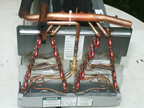 |
 |
 |
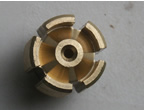 |
||
| Coil with changeable calibrated orifice Bottom: Shows Orifice |
A “W” coil with thermostatic expansion valve | An “A” coil with thermostatic expansion valve |
We also recommend an electronic time delay which will help protect the air conditioning system from damage due to short cycling and lightning.
 |
When we install your new air conditioning system we will evacuate the system with a two stage rotary vacuum pump and use a micron gauge to measure the vacuum. We will evacuate to 500 microns or less to remove the air and moisture from the refrigerant system. We do not use a gauge that reads vacuum in inches of mercury, because it is not accurate enough. There are 25,400 microns in an inch. If the air and moisture is not removed, the efficiency of the unit is less than the rated efficiency and it is likely that you will have pre-mature compressor failure. A micron gauge reads very low vacuum levels. Most manufacturers want to see the system evacuated to 500 microns.
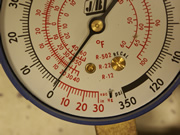 |
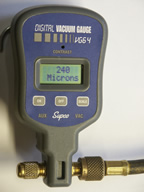 |
| Regular Refrigeration gauge | Micron Gauge |
 |
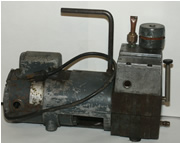 |
|
Micron Gauge
|
Vacuum Pump
|
Moisture and air in the system will create acid which will destroy your compressor.
We will also do a precision electronic tune up on a warm day to make sure that your unit works properly. This insures that you get the efficiency that the unit is rated for.
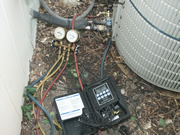 |
| Used for precision electronic tune-up |
Because we do it right we can give our customers a minimum of a two year labor warranty with any air conditioning installation. Call or E-mail us for details.